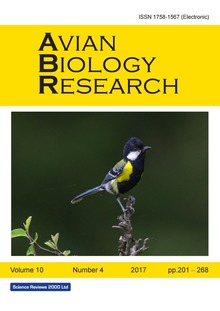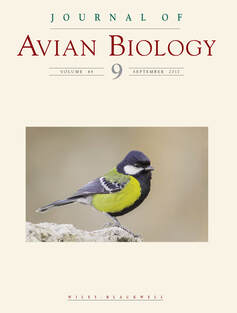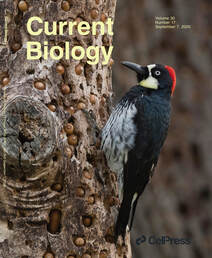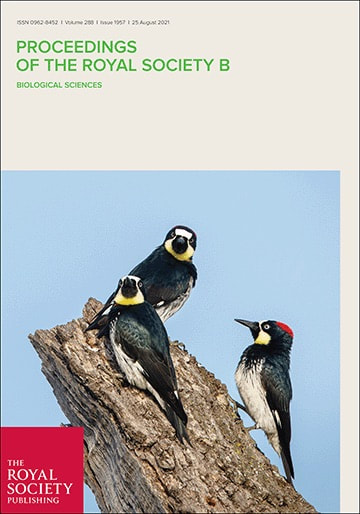PUBLICATIONS (Google Scholar)
37. Barve S., Bakley T. D., Tringali A., Fitzpatrick J.W., Bowman R., (In review, Ornithology). Warm winters lead to increased breeding effort, but lower reproductive success: Hidden costs of climate warming in a threatened bird.
36. Beauchamp G., Barve S. (2023). Gazing Strategies among Sentinels of a Cooperative Breeder Are
Repeatable but Unrelated to Survival. Biology 13: 458 (Link)
35. Bala R., Kumar S.R., Gokhale P., Mohan D., Barve S. (2024). House sparrows Passer domesticus show an increase in body size and dorsal feather insulation along a Himalayan elevational gradient. Journal of Field Ornithology 95 (2):10 (Link)
34. Heather M. H., Bakley T., Barve S. (2024) Florida Scrub-Jay (Aphelocoma coerulescens) pair constructs highest nest on record for the species. Florida Field Naturalist 52 (11): 11-16
33. Menon T., Ramesh V., Barve S. (2023). Himalayan birds that show the greatest elevational shifts remain within the narrowest thermal regimes. Global Ecology and Biogeography 32: 2111-2121.
Featured on Mongabay.com
32. Johnson A.E.*, Barve S.*, Dreiss L., Shizuka D., Walters E.L. (2023). Smoke alters patterns of movement and association in a cooperatively breeding bird. Current Biology 19: R996-R997 (* equal first authors) (Link)
31. Beauchamp G., Barve S. (2023). Multiple sentinels in a cooperative breeder synchronize rather than coordinate gazing. Animals 13:1524 (Open Access)
30. Koenig W.D., Barve S., Haydock J., Dugdale H.L., Oli M.K., Walters E.L. (2023). Inclusive fitness of cooperative polygamy in the acorn woodpecker. Proceedings of the National Academy of Sciences, USA 120: e2219345120 (Link)
29. Barve S., Daniel Cadena, C. (2022). Variation in insulative feather structure in songbirds replacing each other along a tropical elevation gradient. Ecology and Evolution 12: e8698. (Open access)
28. Shizuka D., Barve S., Johnson A., Walters E. L. (2022). Constructing social networks from automated telemetry data: A worked example using within- and across-group associations in cooperatively breeding birds. Methods in Ecology and Evolution 13:133-143. Preprint available
27. Barve S., Riehl C., Walters E.L., Haydock J., Dugdale H.L., Koenig W.D. (2021). Lifetime reproductive benefits of cooperative polygamy vary for males and females in the acorn woodpecker (Melanerpes formicivorus). Proceedings of the Royal Society B: Biological Sciences 288: 20210579. Link
Featured in Popular Science, Smithsonian Magazine and 7 other news outlets
26. Thompson C.L., Alberti M., Barve S., Battistuzzi F.U., Drake J.L., Govaert L., Partridge C., Yang Y. (2021), Back to the future: Reintegrating biology to understand how past eco-evolutionary change can predict future outcomes. Integrative and Comparative Biology 61:2218-2232. Link
25. Dalvi S, Dixit D., Dharwadkar O., Thackeray T., Barve S., Khot R. (2021). The Sakhalin Leaf Warbler Phylloscopus borealoides: A new species for the Indian Subcontinent, and its status in the Andaman & Nicobar Islands. Indian Birds 17: 65-69 Link.
24. Barve S., Ramesh. V, Dotterer, T.M., Dove, C.D. (2021). Elevation, evolutionary origin, and body size drive variation in thermo-insulative feather structure of Himalayan birds. Ecography 44: 680-689 (Open access)
Featured in BBC News, BBC Global News podcast, NPR News Now podcast (02/15 9pm), Smithsonian Magazine, and 10 other news outlets
23. Barve S., Lahey A.S., Brunner R.M., Koenig W.D., Walters E.L. (2020). Woodpecker wars: Tracking warriors and spectators with telemetry. Current Biology 30: R982-983 Link
Featured in the New York Times, Scientific American, Popular Science, New Scientist, Atlas Obscura, Smithsonian Magazine, Quirks and Quarks a CBC podcast, and 21 other news outlets.
22. Barve S., Shankar Raman T. R., Jathar G., Datta A. (2020). Guidelines for conducting research on nesting biology of Indian birds. Indian BIRDS. 16: 10-11 Link
21. Barve S., Shankar Raman T.R.S., Datta A., Jathar G. (2020). When and how to study the nesting biology of Indian birds: Research needs, ethical considerations and best practices. Indian BIRDS 16: 1-9 Link
20. Barve S., Hagemeyer N.D.G., Winter R. E., Chamberlain S.D., Koenig W. D., Winkler D. W., Walters E L. (2020). Wandering woodpeckers: foray behavior in a social bird. Ecology 101: e02943 Link
19. Koenig W. D., Walters E.L. Barve S. (2019). Does helping- at-the-nest help? The case of the acorn woodpecker. Frontiers of Ecology and Evolution 7: 272. Link
18. Barve S., Koenig W., Haydock J., Walters E. (2019). Habitat saturation results in joint-nesting female coalitions in a social bird. American Naturalist 193: 830-840. Link
17. Ishtiaq F., Barve S. (2018). Do avian blood parasites influence hypoxia physiology in Himalayan birds? BMC Ecology 18:15. Link
15. Barve S., Dixit S., Dhondt A.A., Ishtiaq F. (2017). Sexual dimorphism in breast stripe width and beak eco-morphology in Himalayan Green-backed Tits (Parus monticolus). Avian Biology Research 10: 259-263. Link
14. Ramesh V., Gopalkrishna T., Barve S., Melnick D. (2017). Finer spatial resolution improves accuracy of species distribution models in heterogeneous landscapes - a response to Praveen J. Biological Conservation 213: 247-248.
13. Crisologo T., Joshi V., Barve S. (2017). Jack of all calls and master of a few; vocal mimicry in the Tawny lark (Galerida deva). Avian Biology Research 10: 174-180. Link
Featured in The Hindu
12. Barve S., Dhondt A.A. (2017). Elevational replacement of two Himalayan titmice: interspecific competition or habitat preference? Journal of Avian Biology 48: 1189-1194. * Chosen as cover article. Link
Featured on A Traveller's Guide To Feathers
11. Ramesh V., Gopalkrishna T., Barve S., Melnick D. (2017) IUCN greatly underestimates threat levels of endemic birds in the Western Ghats. Biological Conservation 210: 205-221. Link
Featured on EurekaAlert, ColumbiaNews,The Hindu, Phys.org, FactorDaily, Mongabay.com and other news outlets
10. Barve S., Dhondt A., Mathur V.B., Ishtiaq F., Cheviron Z. (2016). Life-history characteristics influence physiological strategies to cope with hypoxia in Himalayan birds. Proceedings of the Royal Society B: Biological Sciences 283: 20162201. Link.
Featured on All About Birds
9. Barve S., La Sorte F.A. (2016) Fruiting season length drives the global distribution of female-only parental care in frugivorous passerines. PLoS ONE 11: e0154871. doi:10.1371/journal.pone.0154871. Link
8. Dixit S., Joshi V., Barve S. (2016). Bird diversity of the Amrutganga Valley, Kedarnath, Uttarakhand, India with an emphasis on the elevational distribution of species. Checklist 12: 1874. Link
7. Barve S., Dhondt A. (2015). A yellow browed tit Sylviparus modestus nest from Kedarnath Wildlife Sanctuary,Uttarakhand, India. Indian Birds (3&4): 110-111. Link
6. Barve S.*, Mason N.* (2015). Interspecific competition affects evolutionary links between cavity nesting, migration and clutch size in Old World flycatchers (Muscicapidae). Ibis 157: 299-311. Link. (* Denotes equal contributions).
5. Fry BG, Hendrikx I, Rowley P, Jackson TNW, van der Ploeg H, Johnson R, Sasa M, Dunstan N, Barve S, Lock B, Phillip T, Zivkovic M, Wiley K, Harrison J, Carmichael R, Morris C, Brandl D, Shankar G, McCarthy S, Sunagar K, Pittman J, Cochran C. Maintaining venomous animal collections: protocols and occupational safety (2017). Venomous Reptiles And Their Toxins: Evolution, Pathophysiology And Biodiscovery. Oxford University Press.
4. Barve S. and Warrier R. (2013). Birds of the Sharavathy Landscape. lndian Birds 8: 57-61. Link.
3. Muralidhar A. and Barve S. (2013). Peculiar choice of nesting site in Red wattled lapwing (Vanellus indicus) in an urban site. Indian Birds 8: 6-9. Link.
2. Barve S. (2010). Sri Lanka Frogmouths of Kogar filling in the gaps. Indian Birds 5: 179. Link.
1. Barve S., Mohan D., and Qureshi Q. (2009). Responses shown by bird communities to teak plantations and surrounding natural forests in Sagar Forest Division, Karnataka, India. Master’s thesis submitted to the Wildlife Institute of India. Link.
POPULAR ARTICLES
Barve S. and Scarl J. 2022. Creating a Culture of Inclusion & Belonging at AOS & BC 2022.
Blog article for americanornithology.org
Barve S. 2022. The unique physiologies of elevational niche shifters. Current Conservation 15.4.
Barve S. 2020. Himalayan birds: Balancing elevation and weather. Sanctuary Asia (October). Link
Barve S. and other contributors. 2020. Fifty things we have learnt about the Earth since the first Earth day. Smithsonian Magazine.
Barve 2017: Immortal Flatulence. Scienceoutside.com.
Barve S. 2015. Drop of Blood. Sea of Information. The Deccan Herald (Spectrum), September 29 2015.
Barve S. 2015. Banded Tickell's Thrush, Uttarakhand. Conservationindia.org.
Barve S. 2014. The Eurasian Woodcock, Kedarnath, Uttarakhand. Conservationindia.org.
Ghuman S., Barve S. Coexistence: Photofeature, Current Conservation 8 (1) 3-3
Barve S. 2014. The Shola Sky-lands. Saevus 3(7) 22-27.
Barve S. 2014. Snake Translocation: New information, new insights. Nature Kaleidoscope, Bulletin
of the Wildlife Institute of India. February 13, 2014.
Barve S. 2013. Translocation Tragedies: Are we really "rescuing" snakes? Conservationindia.org.
Barve S. 2009. The Fox, Outfoxed. Hornbill, July- September: 4-8.





